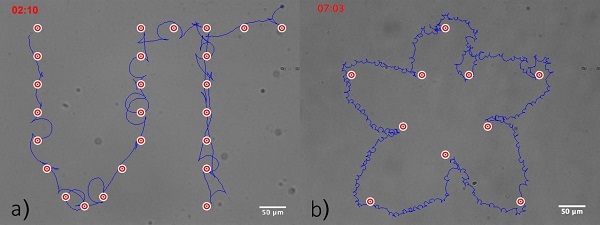Controlling microparticles from afar Do self-propelled particles dream of electric bacteria?


Results of remotely controlled particle movement
Scientists created the letters "UT" (left) and a cherry blossom (right) by using a feedback-control program to maneuver particles to a set of target locations, depicted as concentric red and white circles, popping up one after another. The trajectory of the particle is shown in blue.
© 2017 The University of Tokyo.
A University of Tokyo research team developed a new method that allows them to remotely control and move a micron-sized particle to a desired position. This particle, which can be produced in mass quantity at one time, acts as a self-propelled particle capable of maneuvering itself through water by drawing energy from an electric field and possesses two swimming modes—propulsion and rotation.
Until now, guiding a self-propelled microparticle to an intended target in water proved challenging because it swims completely at random. Furthermore, the smaller the particle the more chaotic its motion becomes due to collisions with surrounding atoms and molecules, posing a problem particular to the maneuvering of tiny objects.
Inspired by the swimming strategy observed in bacteria such as E.coli, the research group led by Professor Masaki Sano at the University of Tokyo’s Graduate School of Science demonstrated that a particle can be transported to a target or follow a given trajectory by remotely switching between the two swimming modes. Moreover, the group theoretically revealed that the optimal strategy for such micron-sized objects to swim towards a target depends on the size of the swimmer: It found that constant steering is beneficial for large particles, while for objects as small as E.coli (about 1μm), a strategy in which a swimmer corrects its orientation only when it veers too far from the intended target, is optimal.
The current outcome provides not only a basic principle for maneuvering small objects, but it may also lead to advanced artificial cell technologies, cell manipulation and stimulation methods, new drug delivery systems, and other applications.
"We initially set out to make self-propelled particles that move in a straight line, but ended up producing a lot of rotating particles,” says Sano. He continues, "We didn’t regard these as a failure and throw them away, but instead turned failure into success by coming up with the algorithm that transports particles towards a target position by switching between the dual modes of rotation and propulsion."
"When we started this project, we never imagined we would get this far," say Tomoyuki Mano, an undergraduate at the time, and Dr. Jean-Baptiste Delfau, who were involved in this study from the outset.
Press release (Japanese)
Paper
, "Optimal run-and-tumble based transportation of a Janus particle with active steering", Proceedings of the National Academy of Sciences of the United States of America Online Edition: 2017/03/15 (Japan time), doi: 10.1073/pnas.1616013114.
Article link (Publication, UTokyo Repository)
Links
Department of Physics, Graduate School of Science
Sano Laboratory, Department of Physics, Graduate School of Science






